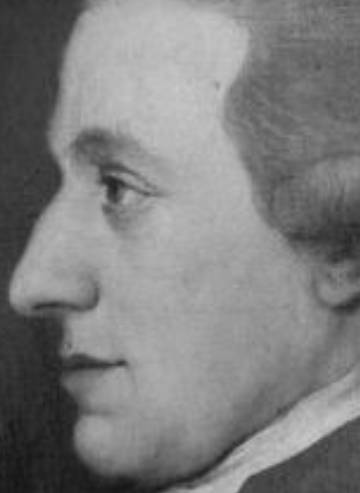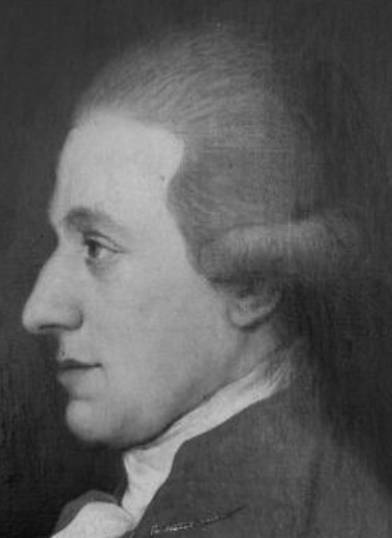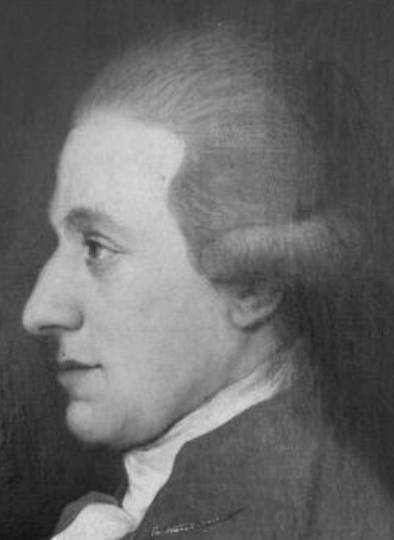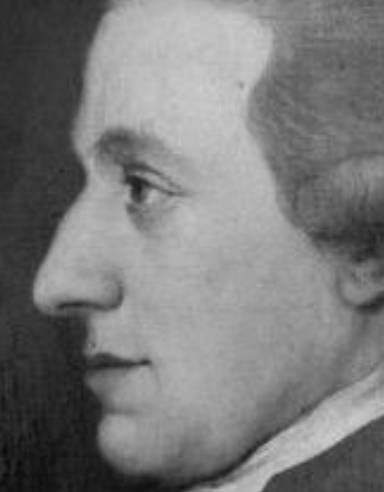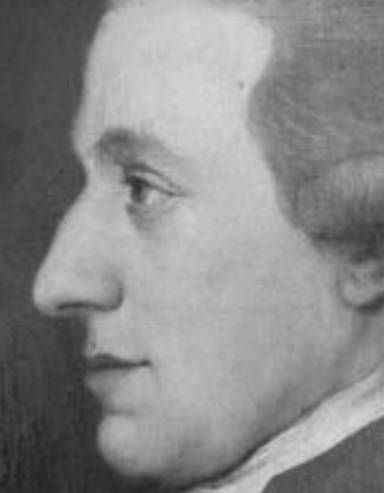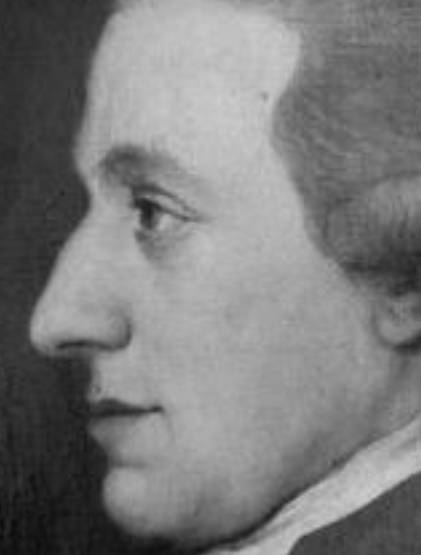
mid-1780s
A
biometrical statistical identification
Martin
Braun - December 2005
In 2004 a new candidate for a painted portrait of the adult Wolfgang Amadeus Mozart (1756-1791) was found in a private art collection in Denmark. It could be traced back to another collection that contained several items from the estate of Johann Lorenz Hagenauer (1712-1792), the friend, landlord, and business partner of Leopold Mozart, the father of W.A. Mozart. Independently from the historical analysis, art expertise attributed the painting to the 18th century (see companion publications).
Here, a biometrical statistical comparison of the portrait with the five known authentic adult portraits of W.A. Mozart is reported. The result is that the person shown by the newly discovered portrait has to be considered as the same person as the one shown by the other five portraits, with an error probability of well below one in 300,000. A comparison of the age related facial traits further revealed that the portrait shows W.A. Mozart from a date between 1782 and 1789, probably from around 1785.
1. The five reference portraits
M1. Anonymus, Austria 1777, now Civico Museo Bibliografico
Musicale, Bologna, Italy.
M2. Della Croce 1780-81, now Internationale Stiftung
Mozarteum, Salzburg, Austria.
M3. Lange 1782-89, now Internationale Stiftung Mozarteum,
Salzburg, Austria.
M4. Stock 1789, now Internationale Stiftung Mozarteum,
Salzburg, Austria.
M5. Edlinger 1790, now Berliner Gemäldegalerie,
Berlin, Germany.
Each of the five portraits is confronted with the new portrait in the
photo section below.
2. Landmark test on non-identity
Face identification is largely determined by proportions and angles of
landmark distances, such as length of nose. Comparison of these parameters
reveals two possible indications of non-identity. First, the height of
the lower jaw is smaller in M3 than in the new face.
Second, the lower jaw in M4 is receding, or drawn back,
which is not the case in the new face. Because none of these two singular
deviations is replicated in any of the other four authentic companion
faces, the corresponding deviations in landmark distances have to be excluded
here. Thus, the overall landmark test on non-identity is negative, and
identity of the new face with the other ones remains possible.
3. Feature test on non-identity
Most faces have a number of non-general features, such as an elevation
on the ridge of the nose. The comparison of such features between the
five known faces and the new face shows no significant difference. Thus,
also the feature test on non-identity is negative, and identity of the
new face with the other ones remains possible.
4. Digital feature test on identity
Many faces have a number of digital features. These are features that
are either obviously present or obviously absent. If different portraits,
for which the non-identity tests have been negative, have a sufficient
number of digital features in common, the probability of subject identity
can be determined statistically. The following seven digital features
appear both in the new face and in the five known faces:
1) Hanging cheeks (age related trait, missing in M1
and M2).
2) Horizontal wrinkle line halfway between mouth and tip of chin.
3) Elevation on the ridge of the nose.
4) A horizontal indentation across the root of the nose.
5) Dark half-circles (suffused skin tissue) below the eyes.
6) Fold of upper eyelid in parallel to (!) and displaced from (!) edge
of eyelid.
7) Horizontal dip in plane of forehead.
Because the seven features are visible at almost all light conditions, their frequency in the general population could be determined by feature counts in public portrait galleries.
From the corpus of 103 adult Caucasian male portrait paintings, which was set up for an earlier study (Braun, 2005 and 2006ab) and which was based on the portraits in the internet archives of the National Gallery of the USA and the Gemäldegalerie in Berlin, all portraits had to be excluded where forehead or lower jaw were either covered (by clothing or beard) or were not painted accurately enough. Further, because traits 1 and 5 can develop in a later period of adult life and Mozart died at 35, all portraits had to be excluded that showed an apparent age of the sitter of clearly above 40. After the exclusions, 30 portraits remained in the corpus. It was then extended by applying the same filters to all portraits in the internet archives of the Musée du Louvre in Paris and the National Gallery in London. Thus, further 13 and 17 pieces, respectively, entered the corpus, raising the total number to 60.
From the earlier study's corresponding corpus of 103 portrait photographs, which had been set up from the random results of Google picture searches, 70 remained after applying the same exclusion rules as described above.
The count of feature frequencies, separately for paintings and photographs, revealed that in both databases trait 1 and 2 appeared in the same face more often than could be expected from their single frequencies. This observation is biologically plausible, because the probability of both traits is likely to increase with the amount of under-skin tissue in the lower jaw. Therefore, the co-occurrence of these two traits in a face had to be considered as a single new trait.
Similarly, the count of feature frequencies, separately for paintings and photographs, also revealed that in both databases trait 5 and 6 appeared in the same face more often than could be expected from their single frequencies. Also this observation is biologically plausible, because the probability of both traits may depend on qualities of under-skin tissue that are similar above and below the eye. Again, the co-occurrence of these two traits in a face had to be considered as a single new trait.
For traits 3 and 4 the frequencies had already been determined in the mentioned earlier study. For the other traits the frequencies were determined by using the new databases. The complete results are as follows:
1 & 2) Hanging cheeks AND horizontal line on chin: 8
% in paintings, 6 % in photographs.
3) Elevation on the ridge of the nose: 5 % in paintings, 1 % in photographs.
4) Indentation across the root of the nose: 7 % in paintings, 2 % in photographs.
5 & 6) Dark half-circles below the eyes AND described fold of upper
eyelid: 8 % and 9 %.
7) Horizontal dip in plane of forehead: 12 % and 19 %.
Next, these five features were tested on correlations. Because all tests were negative and because there is also no biological rationale to assume any correlation, the five features have to be considered as stochastically independent. Thus, the frequency of their joint occurrence is computed by multiplication of the single frequencies. The results for the probability that two non-relatives have the five features in common are below one in 370,000 re the painting database, and below one in 5,800,000 re the photo database.
Further, it should be noted that the probability estimates would have become even more decisive, if the many non-digital features that the new face has in common with the other five faces had entered the calculation.
5. Time window for the date of the new face
Traits 1 and 5 can be age related. In the face of W.A. Mozart, trait
1 only appears after 1782, and trait 5 has increased after 1782. Trait
1 of the new face is not as fully developed as in M4
and M5. This would date the new face as before 1789.
Because trait 1 is missing in M1 and M2,
the new face must be dated as later than 1782. This gives us a time window
of 1782-1789.
Trait 5 in the new face is about as strong as in M1,
M2, and M3, but weaker than in M4
and M5. This again places the painting in the window
of 1782-1789. Assuming a smooth development of these two age-related traces
in W.A. Mozart, the painting would reflect his face from a date near 1785.
6. Possibility of post-mortem construction
The possibility that somebody constructed the "Hagenauer Mozart"
on the bases of one, or several, of the five authentic portraits seems
unrealistic. The two profile portraits, M3 and M4,
would appear unlikely as possible originals for the new face, because
each deviates on an important issue (see above). M1
and M2 seem unlikely as possible originals, because
they lack trait 1. Finally, also M5 seems unrealistic
as a possible original, due to the differences of age or health status,
or both. Therefore, as long as there is no evidence to the contrary, the
"Hagenauer Mozart" has to be considered as an authentic portrait
of W.A. Mozart from around 1785.
Addendum March 16, 2008
The publication of this report in January 2006 led to multiple investigations
in many parts of the world. In October 2006, the well-known Mozart expert
Daniel Leeson, USA, found archival evidence that conclusively ties the
portrait to W.A. Mozart. In the same month, the present author wrote a
communication of this new evidence
and handed it over to other established Mozart experts. One and a half
year later, on March 14, 2008, one of the world's leading Mozart experts,
Cliff Eisen at King's College London, published
the portrait worldwide in the news media as "authenticated"
and "arguably the most important Mozart portrait to be discovered
since the composer's death in 1791".
References
1) Companion publications concerning the "Hagenauer Mozart"
(in press). See also: First
press release.
2) Braun, Martin. The last portrait of
W.A. Mozart: A biometrical statistical comparison. Internet publication
(search title), April 2005. (Republished on demand in: Mozart-Jahrbuch
2005 des Zentralinstitutes für Mozartforschung der Internationalen
Stiftung Mozarteum Salzburg/Austria, 2006, pp. 253-255.)
3) Braun, Martin. Das letzte Portrait von Wolfgang Amadeus Mozart: Ein
biometrisch-statistischer Vergleich. In: Gemäldegalerie, Staatliche
Museen zu Berlin (Ed.), Das Mozartportrait in der Berliner Gemäldegalerie.
Staatliche Museen zu Berlin Preußischer Kulturbesitz, Berlin 2006a,
pp. 19-22.
4) Braun, Martin. Das letzte Portrait von Wolfgang Amadeus Mozart: Ein
biometrisch-statistischer Vergleich. In: Keller, P., Kircher, A. (Eds.),
Zwischen Himmel und Erde - Mozarts geistliche Musik: Katalog mit CD, 256
Seiten. Verlag Schnell & Steiner, Regensburg 2006b, pp. 75-76.

